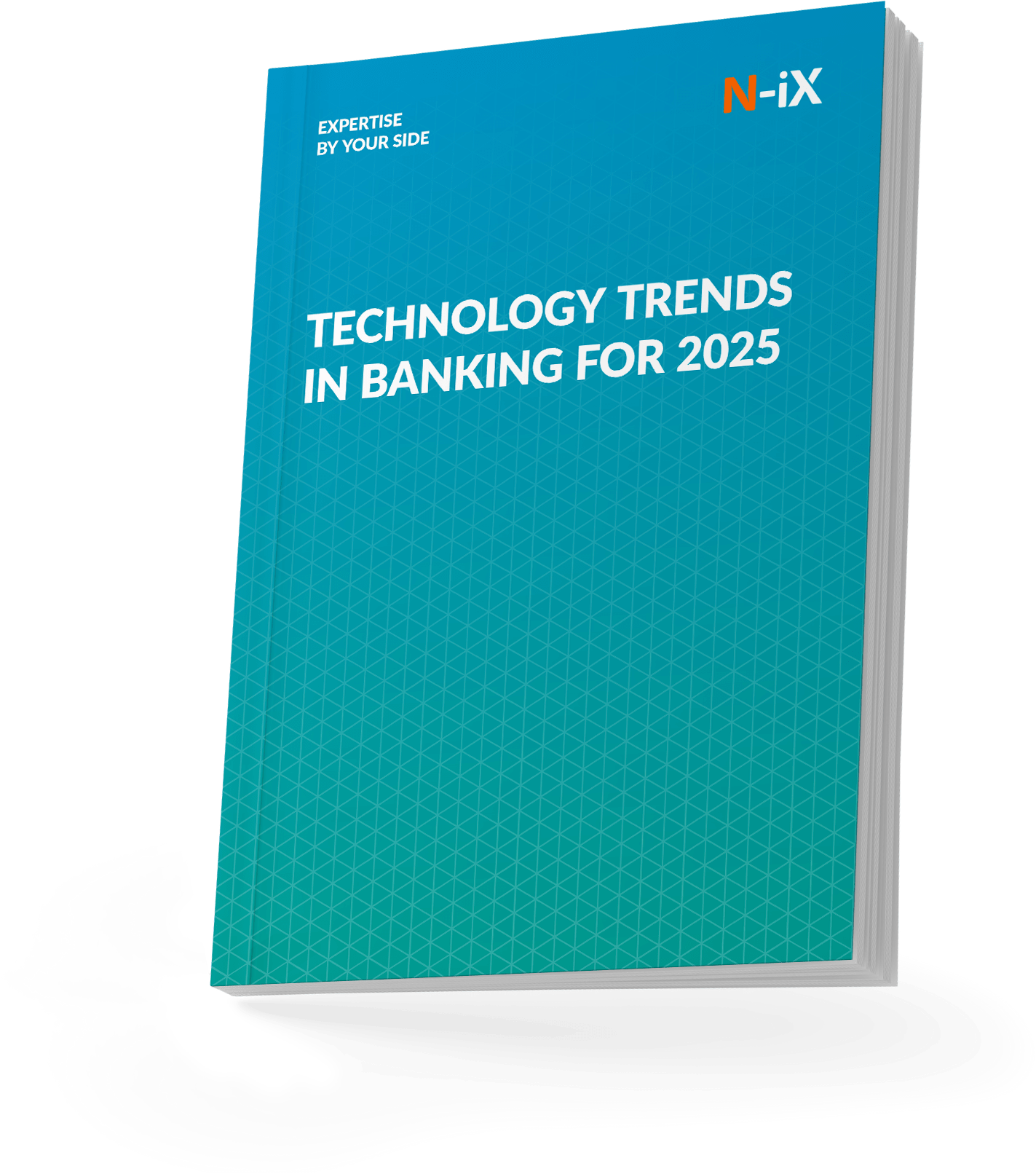It is becoming increasingly clear: digital transformation in banking is an existential necessity to stop the mounting accumulation of technical debt and regain customer loyalty. According to the survey conducted by Gartner in 2023, 47% of consumers are considering switching to fintech providers due to the lack of a personalized digital user experience offered by their current bank. Actions back this sentiment: approximately half of all new checking accounts opened in 2023 were with fintech companies. Yet, only a third of executives in banking consider Big Tech a threat to their business and hesitate to invest in financial services software development and digital transformation services.
Over the past two decades, the world has been reinventing itself, becoming increasingly customer-oriented and convenient. We expect virtually any information or task to be effortlessly accessed and completed within minutes via intuitive UI and personalized recommendation systems. The skills young developers learn are also changing with the times. There are fewer and fewer developers who can work with programming languages and systems, sometimes double their age: 47% of CFOs reported having issues with hiring talent in banking [1].
According to Gartner, banks that choose not to undergo transformation risk experiencing a substantial decline in operational efficiency and market trust and undermining their chances to exist within the next two years. Let's explore the stages of digital transformation in banking, from the simplest to the most advanced.
Steps to digital transformation in banking
Digital transformation in banking is the adoption of modern digital technologies and strategies to fundamentally improve how banks operate, interact with customers, and deliver financial services. While the term is not precisely defined, it generally refers to the process of keeping up with technological progress and regaining competitiveness in the industry. Here is the path from the very beginning to complete digital transformation in banking:

1. Repaying the technical debt
Technical debt refers to the accumulation of outdated, inefficient, or suboptimal software within a bank's IT systems. It occurs when past decisions prioritize quick fixes, expedited delivery, or cost savings over long-term optimal solutions. For instance, a bank might have implemented a software solution to comply with a new regulation using unscalable or poorly integrated workarounds. Technical debt has a snowballing effect as each additional customized integration to unoptimized systems becomes more costly.
Repaying technical debt involves several strategic steps. The first step is to comprehensively audit existing systems and software to identify areas burdened by technical debt. Based on this audit, a strategic plan is developed, which outlines the timelines, resources, and investments required to address the identified issues.
This plan typically includes replacing or upgrading legacy systems with modern technologies that enhance scalability, security, and efficiency. To prevent the accumulation of future technical debt, coding standards and best practices are implemented. Automation is leveraged in testing, deployment, and monitoring processes to minimize manual errors and improve operational efficiency.
2. Updating data management and cybersecurity systems
At the core of banking software development lies the management of extensive financial data, which includes transactions, customer information, and compliance reports. An upgraded data management system must guarantee this data's accuracy, consistency, and reliability.
A data management system should also integrate advanced security protocols and encryption to protect against breaches. This is crucial not only for maintaining customer trust and safeguarding against cyber attacks but also for establishing a long-term solution to future regulatory requirements. Incorporating new compliances into a system that is up-to-date is significantly easier and more cost-effective in the long term.

3. Developing modern customer-facing services
Another crucial step in digital transformation is the development of systems and applications that enhance the customer experience. In 2023, 71% of customers stated that online banking is their preferred banking channel; the remaining 29% are split between ATMs, bank branches, and phone calls [2]. The user-friendly interfaces and accessibility of mobile apps bring convenience for all users, and an omnichannel approach provides a seamless and consistent banking experience across channels.
The trend towards personalization, particularly in mobile banking apps, is a significant aspect of modern banking services. 47% of consumers indicated they would switch to a provider offering a smoother, more personalized user experience if their current service's landing page is not personalized [3]. Data analytics and AI can be used to tailor the user experience, offering personalized financial advice and product recommendations directly within their apps. This level of personalization can include customized home screens that display relevant account information, notifications, and suggestions based on the user's banking behavior, preferences, and financial goals.
4. Implementing RPA solutions
Robotic Process Automation (RPA) drives efficiency, reducing operational costs and enhancing customer satisfaction. RPA means that bots are used to automate highly repetitive and routine tasks previously performed by humans. In banking, RPA solutions are implemented across various functions, from front-office customer service to back-office operations. Here are several examples of RPA in banking:
- Loan and mortgage processing: RPA speeds up loan application review, document verification, credit checks, and approvals. Bots pull data, assess creditworthiness, and initiate background checks, reducing processing times significantly.
- Fraud detection: RPA systems monitor real-time transactions to detect and flag fraud. By analyzing patterns and comparing transactions against known fraud indicators, RPA quickly identifies suspicious activities and alerts investigators, enhancing risk management efforts.
- Account reconciliation: Bots automate account reconciliation by matching bank statements with ledgers, ensuring faster reconciliation, accuracy, and compliance with financial reporting standards.
- Report generation: RPA bots automate data compilation and report generation for compliance, auditing, and management purposes, freeing up resources for more strategic tasks.
- KYC compliance: Automating KYC with RPA helps banks collect, process, and verify customer information to comply with anti-money laundering laws. RPA speeds up the KYC process, reduces errors, and ensures compliance.
Read more: SAP automation in banking with RPA and Automation Anywhere
5. Adapting the business model
In the early stages of digital transformation, regulations such as open banking are merely legal requirements. However, complete digital transformation takes a more proactive approach. Rather than viewing them solely as obligations, banks now see them as opportunities to innovate and enhance their services. This involves embracing digital infrastructure upgrades as a strategic asset.
One of the most significant opportunities arising from open banking APIs is partnering with fintechs. In this collaboration, banks can quickly introduce new services and experiences to their customers, leveraging the innovative capabilities and speed to market these companies. This partnership might show the opportunity to change the traditional banking business model to more progressive sources of revenue. Here are two examples of an alternative business model for banks:
- Banking as a Service (BaaS): Means that the bank's product is the provision of core banking infrastructure by banks to external clients as a service. The demand for this service is created by banks looking to quickly replace their legacy core banking system and fintechs that operate without a banking license.
- Banking as a Platform (BaaP): When multiple financial institutions join a BaaP, they effectively merge their client bases and facilitate an effective matching of customers to financial services. This process resembles the functioning of online marketplaces, where diverse sellers present their offerings to buyers via a shared platform.
Read more:
- Open Banking strategy for US and Canadian banks
- Core banking modernization: A roadmap for minimizing risks
6. Rolling out new services
Having built an efficient financial data management system, banks can utilize their data analytics capabilities to deliver additional value to their customers. Amid the current economic downturn, receiving assistance with personal financial management is a highly valuable feature for the majority of customers [4]. This assistance may involve personalized investment recommendations and customized budgeting strategies tailored to their individual financial circumstances.
Currently, 48% of British customers do not believe their bank has their best interests in mind [5]. This is explained by unclear communication, confusion about whether particular services align with the individual financial goals, and the lack of features related to personal financial management. Implementing simple data analytics tools can significantly impact clients' lives and foster the belief that their bank cares about their financial well-being and is a trustworthy partner in its improvement. Ultimately, customers confident in their financial provider are more likely to take advantage of additional services [6].

The growth of fintechs is a testament to the huge demand for innovative financial services in all categories. The fastest-growing areas are embedded finance, SME and corporate, and capital markets services. Here are some examples of innovative financial services:
- Buy Now, Pay Later (BNPL) allows retailers to offer customers the option to purchase items and pay for them over time without traditional credit checks. This service is integrated directly into the checkout process, making it seamless for consumers.
- Embedded investments: platforms like Robinhood or Acorns integrate investment services into various consumer apps, allowing users to invest spare change automatically from everyday purchases or to trade stocks without leaving their favorite financial management apps.
- Peer-to-peer (P2P) lending is an innovative financing model that allows businesses to borrow money directly from individual investors. P2P lending can be more accessible, flexible, and convenient than traditional loans, especially for SMEs that may not meet the stringent criteria of banks.
Read more: Digital Transformation: How Technology Reshapes Financial Markets
Conclusion
The shift to digital is not just a competitive advantage but a necessary step to survive in a time when fintech companies are gaining more and more market share by simply providing better digital experiences. Modern customers want banking services that are personalized, efficient, and easy to access, and they are ready to switch to providers who offer these advantages.
Stay ahead in banking—explore 6 tech trends shaping the industry in 2025!


Success!

Why choose N-iX to guide you through digital transformation

Resources:
- CEO and Senior Business Executive Survey, Gartner 2022
- Consumer Survey Banking Methods, American Bankers Association 2023
- Digital Banking Ebook, Finshape 2023
- Consumers Expect Financial Advice: Banks Are Falling Short, The Financial Brand 2022
- Low trust amongst banking customers as recession looms, GFT 2022
- Ibid.
Have a question?
Speak to an expert




